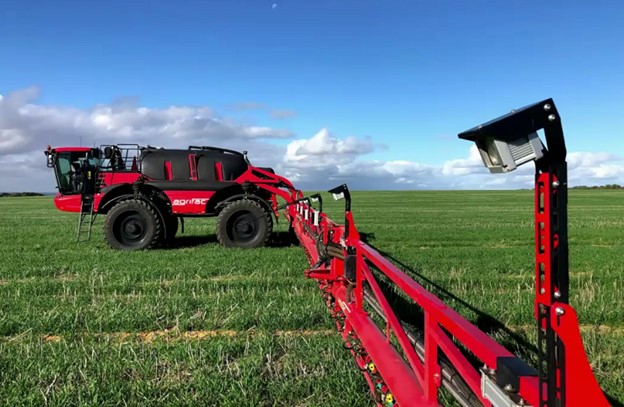When French classmates Guillaume Jourdain, Hugo Serrat and Jules Beguerie were looking at applying AI to agriculture in 2014 to form a startup, it was hardly a sure bet.
It was early days for such AI applications, and people said it couldn’t be done. But farmers they spoke with wanted it.
So they rigged together a crude demo to show that a GeForce GPU could run a weed-identification network with a camera. And next thing you know, they had their first customer-investor.
In 2016, the former dorm-mates at École Nationale Supérieure d’Arts et Métiers, in Paris, founded Bilberry. The company today develops weed recognition powered by the NVIDIA Jetson edge AI platform for precision application of herbicides at corn and wheat farms, offering as much as a 92 percent reduction in herbicide usage.
Driven by advances in AI and pressures on farmers to reduce their use of herbicides, weed recognition is starting to see its day in the sun. A bumper crop of AI agriculture companies — FarmWise, SeeTree, Smart Ag and John Deere-owned Blue River — is plowing this field.
Farm Tech 2.0
Early agriculture tech was just scratching the surface of what is possible. Applying infrared, it focused on “the green on brown problem,” in which herbicides were applied uniformly to plants — crops and weeds — versus dirt, blasting all plants, said Serrat, the company’s CTO.
Today, the sustainability race is on to treat “green on green,” or just the weeds near the crop, said Serrat.
“Making the distinction between weeds and crops and act in real time accordingly — this is where everyone is fighting for — that’s the actual holy grail,” he said. “To achieve this requires split-second inference in the field with NVIDIA GPUs running computer vision.”
Losses in corn yields due to ineffective treatment of weeds can run roughly 15 percent to 20 percent, according to Bilberry.
The startup’s customers for smart sprayers include agriculture equipment companies Agrifac, Goldacres, Dammann and Berthoud.
Cutting Back Chemicals
Bilberry deploys its NVIDIA Jetson-powered weed recognition on tractor booms that can span a U.S. football field — about 160 feet. It runs 16 cameras on 16 Jetson TX2 modules and can analyze weeds at 17 frames per second for split-second herbicide squirts while traveling 15 miles per hour.
To achieve this blazing-fast inference performance for rapid recognition of weeds, Bilberry exploited the NVIDIA JetPack SDK for TensorRT optimizations of its algorithms. “We push it to the limits,” said Serrat.
Bilberry tapped into what’s known as INT8 weight quantization, which enables more efficient application of deep learning models, particularly helpful for compact embedded systems in which memory and power restraints rule. This allowed them to harness 8-bit integers instead of floating-point numbers, and moving to integer math in place of floating-point helps reduce memory and computing usage as well as application latency.
Bilberry is a member of NVIDIA Inception, a virtual accelerator program that helps startups in AI and data science get to market faster.
Winners: Environment, Yields
The startup’s smart sprayers can now dramatically reduce herbicide usage by pinpointing treatments. That can make an enormous difference on the runoff of chemicals into the groundwater, the company says. It can also improve plant yields by reducing the friendly fire on crops.
“You need to apply the right amount of herbicides to weeds — if you apply too little, the weed will keep growing and creating new seeds. Bilberry can do this at a rate of 242 acres per hour, with our biggest unit” said Serrat.
The focus on agriculture chemical reduction comes as Europe tightens down on carbon cap limits affecting farmers and as consumers embrace organic foods. U.S. organic produce sales in 2020 increased 14 percent to $8.5 billion from a year ago, according to data from Nielsen.
Potato-Sorting Problem
Bilberry recently launched a potato-sorting application in partnership with Downs. Potatoes are traditionally handled by sorting potatoes moving slowly across a conveyor belt. But it’s difficult for food processors to get the labor, and the monotonous work is hard to stay focused on for hours, causing errors.
“It’s really boring — doing it all day, you become crazy,” said Serrat. “And it’s seasonal, so when they need someone, it’s now, and so they’re always having problems getting enough labor.”
This makes it a perfect task for AI. The startup trained its potato-sorting network to see bad potatoes, green potatoes, cut potatoes, rocks and dirt clods among the good spuds. And applying the Jetson Xavier to this vision task, the AI platform can send a signal to one of the doors at the end of the conveyor belt to only allow good potatoes to pass.
“This is the part I love, to build software that handles something moving and has a real impact,” he said.
